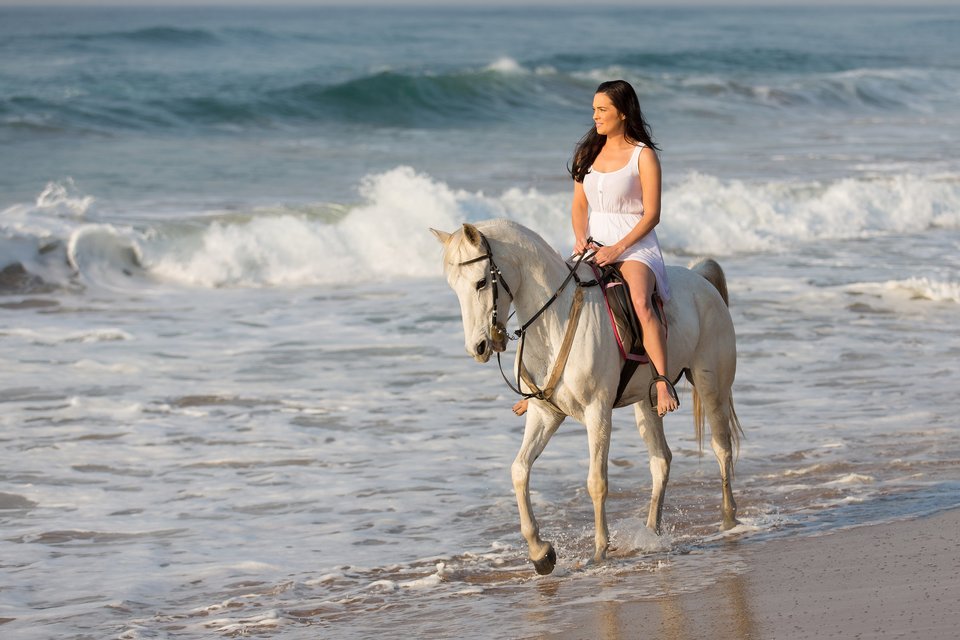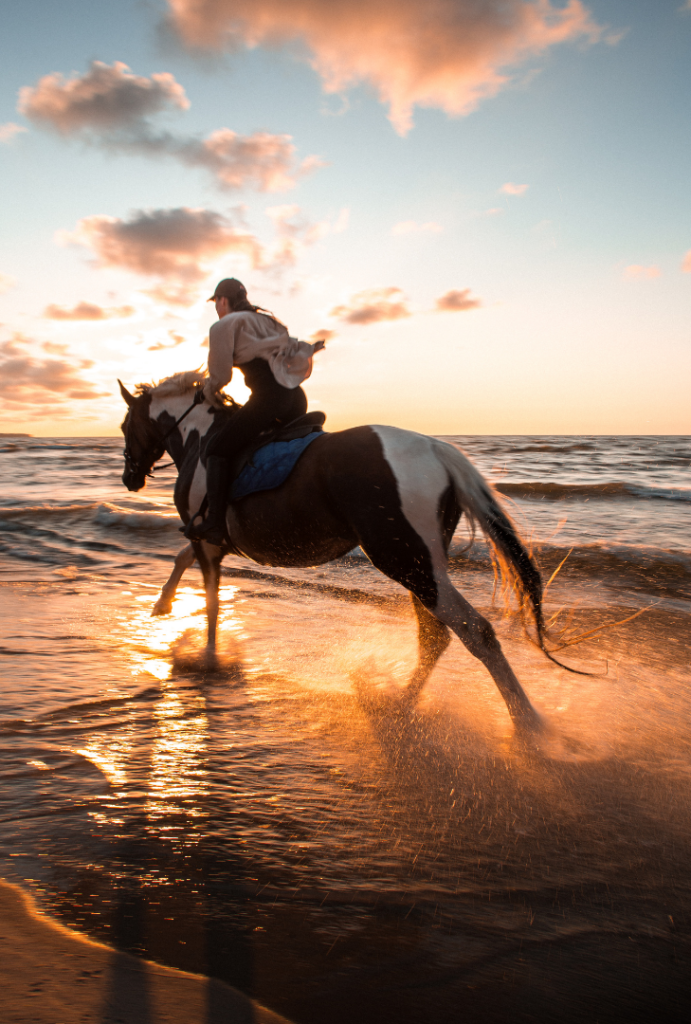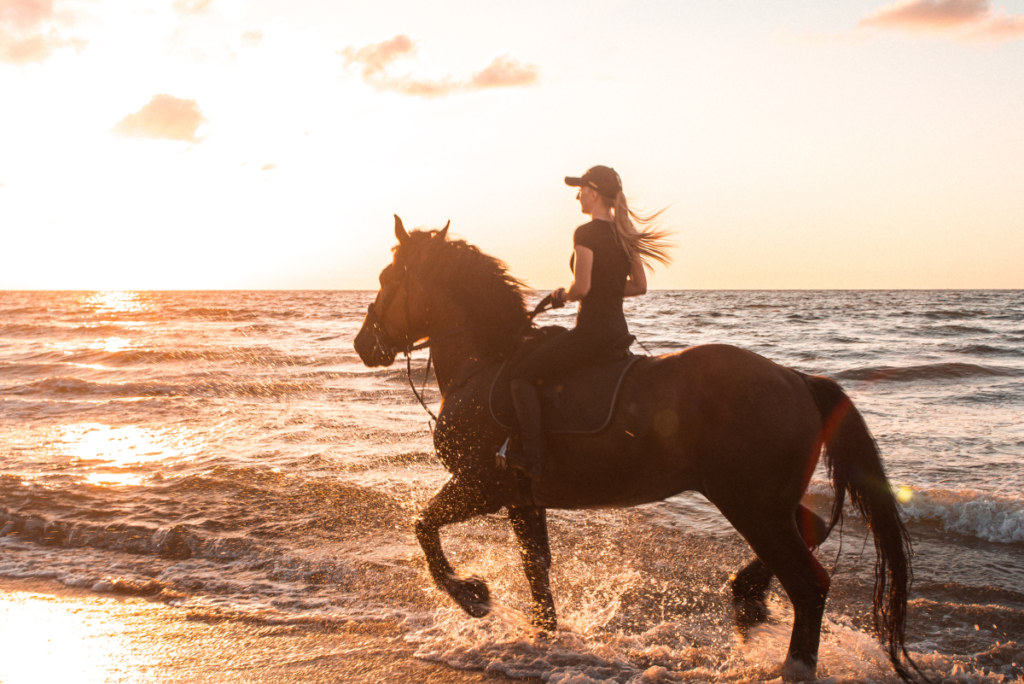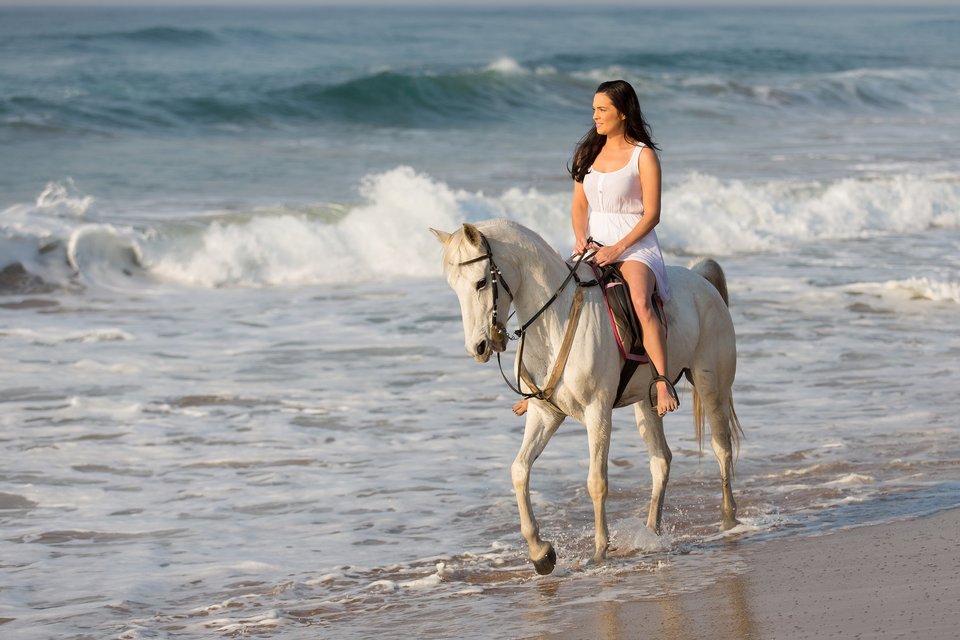Imagine the wind whipping through your hair as you gallop along the shoreline, the rhythmic sound of hooves hitting the sand. Horseback riding on the beach is a truly magical experience that combines the beauty of nature with the elegance of these magnificent creatures. Whether you’re an experienced rider or a novice, this activity offers a unique way to connect with horses and immerse yourself in the tranquility of the ocean. In this article, we will explore the joys and benefits of horseback riding on the beach, from the therapeutic effects to the incredible views. So saddle up and get ready for an adventure unlike any other.
1. Introduction to Horseback Riding on the Beach
When it comes to horseback riding, there is an undeniable sense of freedom and adventure that comes with exploring new terrains. And what better place to experience this thrill than on the beach? Beach horseback riding allows you to combine the exhilaration of riding with the calming sounds of crashing waves and the breathtaking beauty of the shoreline. In this article, we will explore the benefits of horseback riding on the beach, the safety considerations you need to keep in mind, popular beaches for this activity, and the essential equipment and gear required for a memorable beach riding experience.
1.1 Benefits of Horseback Riding on the Beach
Horseback riding on the beach offers a plethora of benefits, both physical and mental. Firstly, it provides an opportunity to connect with nature in a unique and intimate way. As you trot along the sandy shores, you can breathe in the fresh coastal air and take in the scenic views, creating a sense of peace and harmony with your surroundings.
Additionally, beach riding instills a feeling of freedom and liberation as you ride alongside the vast expanse of the ocean. The rhythmic sound of the waves crashing against the shore and the wind in your hair create a sense of exhilaration that cannot be replicated elsewhere.
The tranquility and serenity of the beach also provide a therapeutic escape from the stresses of daily life. The soothing ambiance of the beach, combined with the rhythmic motion of the horse, helps to relax the mind and promote mental well-being.
Lastly, beach riding fosters a unique bond between rider and horse. The horse becomes both your companion and guide on this adventurous journey, creating a deeper connection and trust between you and your equine partner.
1.2 Safety Considerations for Beach Horseback Riding
While beach horseback riding can be an incredibly enjoyable activity, it is essential to prioritize safety. Here are a few safety considerations to keep in mind:
- Always wear a properly fitted helmet to protect your head in case of a fall.
- Ensure that your horse is appropriate for your skill level and has experience riding on the beach.
- Familiarize yourself with the local regulations regarding beach riding and obtain any necessary permits.
- Be aware of tide schedules and weather conditions before embarking on your ride.
- Maintain a safe distance from other beachgoers and respect their space.
By adhering to these safety tips, you can have a memorable and accident-free beach horseback riding experience.
1.3 Popular Beaches for Horseback Riding
If you’re eager to hit the beach for a horseback riding adventure, there are several iconic destinations that offer this unique experience. Here are a few popular beaches known for their horseback riding opportunities:
- Cape Hatteras National Seashore, North Carolina: This expansive beach allows riders to explore miles of shoreline and witness the region’s abundant wildlife.
- Cannon Beach, Oregon: Surrounded by stunning rock formations and the iconic Haystack Rock, horseback riding here offers a picturesque and memorable experience.
- Assateague Island, Maryland/Virginia: Known for its population of wild horses, Assateague Island provides an extraordinary opportunity to ride alongside these magnificent creatures.
- Pismo Beach, California: With its wide sandy shoreline and beautiful ocean views, Pismo Beach is a popular destination for beach horseback riding on the West Coast.
These are just a few examples, but many beaches around the world offer horseback riding opportunities. Research your desired location to find the best beach riding spots near you.
1.4 Equipment and Gear for Horseback Riding on the Beach
Before venturing out for a horseback ride on the beach, it’s important to ensure you have the right equipment and gear. Here are the essential items you’ll need:
- Riding Helmet: Always wear a properly fitted helmet to protect your head in case of a fall or accident.
- Riding Boots: Invest in a pair of sturdy riding boots with a heel to provide stability and prevent your foot from slipping through the stirrups.
- Sunscreen: Protect your skin from harmful UV rays by applying sunscreen before your ride, especially if you’ll be riding for an extended period.
- Swimsuit or Fast-Drying Clothes: If you plan on swimming with your horse, wear a swimsuit or opt for quick-drying clothes to ensure your comfort after getting wet.
- Water Bottle and Snacks: Stay hydrated during your ride by carrying a water bottle and pack some snacks to keep your energy levels up.
- Saddlebag or Backpack: A saddlebag or backpack is handy for carrying essentials such as your phone, keys, and any other personal items.
By having the right equipment and gear, you’ll be prepared for a safe and enjoyable beach horseback riding experience.
2. Experiencing the Freedom and Serenity
2.1 Connecting with Nature
One of the most notable aspects of horseback riding on the beach is the incredible opportunity to connect with nature. As you horseback ride along the sandy shores, you’ll be surrounded by the raw beauty of the coastal landscape. The rhythmic sound of the waves crashing against the shore, the salty scent of the ocean, and the feeling of the sand beneath your horse’s hooves create a truly immersive experience. This connection with nature can be a deeply grounding and therapeutic experience, allowing you to disconnect from everyday stresses and embrace the present moment.
2.2 Sense of Freedom and Liberation
There’s something truly exhilarating about horseback riding on the beach that instills a sense of freedom and liberation. As you ride alongside the vast expanse of the ocean, with the wind in your hair and the sun on your face, you’ll feel a newfound sense of liberation and empowerment. The open space and endless landscape create a sense of boundless possibilities, allowing you to let go of any constraints and fully embrace the present moment.
2.3 Tranquility and Serenity of the Beach
The beach has long been regarded as a sanctuary for tranquility and serenity, and horseback riding only enhances this peaceful ambiance. As you trot along the shoreline, you’ll be enveloped in a sense of calm as the rhythmic motion of the horse and the soothing sound of the waves lull you into a state of relaxation. The beach offers a serene escape from the noise and chaos of daily life, allowing you to find solace in the simplicity and beauty of nature.
2.4 Unique Bond with the Horse
Horseback riding on the beach creates a unique opportunity to strengthen your bond with your horse. The shared adventure and new environment help to foster trust and communication between rider and horse. Through the challenges and triumphs of navigating the sandy terrain, you’ll develop a deeper understanding of each other’s cues, creating a harmonious partnership. This bond extends beyond the ride itself, enhancing your overall relationship with your equine companion.

3. Physical and Mental Health Benefits
3.1 Strengthening and Conditioning
Horseback riding on the beach is not only an enjoyable activity but also a great form of exercise. The constant movement and control required to ride a horse engage various muscles throughout your body, providing overall strengthening and conditioning. Your legs, core, and even your upper body are actively engaged as you maintain balance and control while riding. By regularly participating in beach horseback riding, you can improve your overall fitness and muscle tone.
3.2 Improving Balance and Coordination
Horseback riding, especially on uneven surfaces like the beach, challenges your balance and coordination in a unique way. The constant adjustments and shifts in your body position as the horse moves help to improve your proprioception and stability. This improved balance and coordination transfers to other areas of your life, making everyday movements more fluid and controlled.
3.3 Mental Relaxation and Stress Relief
The therapeutic benefits of horseback riding on the beach extend beyond physical fitness. Engaging in this activity promotes mental relaxation and stress relief. The combination of being outdoors, surrounded by nature, and the rhythmic motion of the horse creates a calming effect on the mind. As you focus on the present moment and the connection between horse and rider, you’ll experience a sense of mindfulness and peace, allowing you to leave behind the stress and worries of daily life.
3.4 Boosting Self-Confidence and Empowerment
Mastering the art of beach horseback riding requires a certain level of skill and confidence. As you navigate the challenges of riding on an unstable surface and adapt to the behavior of your horse in a new environment, you’ll experience a boost in self-confidence and empowerment. Overcoming these challenges and achieving success in your beach riding endeavors will leave you with a sense of accomplishment and a newfound belief in your abilities.
4. Challenges and Rewards
4.1 Riding on an Unstable Surface
Riding on the beach presents a unique challenge due to the unstable surface. The shifting sands can make it more difficult to maintain balance and control. Your horse may also need time to adjust to the changing terrain and find their footing. However, with practice and patience, you’ll develop the skills necessary to navigate this unstable surface, and the rewards will be well worth the effort.
4.2 Tides and Weather Conditions
When planning a beach horseback ride, it’s crucial to consider the tides and weather conditions. High tides can limit the accessible riding area and make it unsafe to ride in certain places. It’s important to familiarize yourself with the tide schedule and plan your ride accordingly. Additionally, adverse weather conditions such as strong winds or heavy rain can impact the safety and enjoyment of your ride. Always check the forecast and make informed decisions to ensure a safe and pleasant experience.
4.3 Adapting to Horse’s Behavior in a New Environment
Horses, like humans, can experience changes in behavior when introduced to a new environment. Beach riding may be a new and unfamiliar experience for your horse, and they may react differently than they would in a familiar setting. It’s essential to observe and understand your horse’s behavior, providing them with the reassurance and support they need to adapt. By being patient and allowing your horse time to acclimate, you’ll foster a sense of trust and confidence in these new surroundings.
4.4 Reward of Overcoming Challenges
Riding on the beach presents a series of challenges, but the rewards associated with overcoming them are immeasurable. The sense of accomplishment and personal growth that comes from conquering a difficult ride builds resilience and confidence. Each successful beach horseback ride strengthens your skills and deepens your connection with your horse, creating memories that will last a lifetime.

5. Safety Tips for Beach Horseback Riding
5.1 Choosing a Trustworthy Horse
When embarking on a beach horseback riding adventure, it’s crucial to choose a trustworthy and well-trained horse. Ensure that the horse is suited to your skill level and has experience riding on the beach. If you’re not familiar with the horse, take a moment to get to know their temperament and behavior before mounting. This will help create a safer and more enjoyable ride for both you and the horse.
5.2 Proper Riding Techniques and Posture
Maintaining proper riding techniques and posture is essential for both safety and comfort during beach horseback riding. Keep the following tips in mind:
- Sit up straight with your shoulders relaxed and your back aligned.
- Keep your feet securely in the stirrups and your heels down.
- Maintain a light but firm grip on the reins.
- Engage your core muscles to maintain balance and stability.
- Look forward and maintain a good line of sight to anticipate any potential obstacles or changes in the environment.
By practicing proper riding techniques, you’ll enhance your control and minimize the risk of accidents.
5.3 Understanding and Managing Tides
Tides play a crucial role in beach horseback riding, as they can significantly impact the safety and accessibility of the beach. Before your ride, familiarize yourself with the tide schedule and plan accordingly, ensuring that you have ample time to ride before the tide comes in. Avoid riding at high tide, as it can limit your riding areas and potentially put you and your horse at risk. By understanding and managing the tides, you’ll have a safer and more enjoyable ride.
5.4 Staying Aware of Surroundings
When riding on the beach, it’s important to stay aware of your surroundings. Keep an eye out for any potential hazards such as rocks, debris, or other beachgoers. Be mindful of your riding speed and adjust it based on the conditions and the proximity of others. Maintaining situational awareness will help prevent accidents and ensure that everyone can enjoy the beach safely.
6. Regulations and Code of Conduct
6.1 Local Regulations and Permits
Before heading to the beach with your horse, it’s vital to familiarize yourself with any local regulations regarding beach riding. Some beaches may require permits or have specific rules and guidelines in place. Research the regulations specific to your desired beach riding location to ensure compliance and prevent any unnecessary complications or fines.
6.2 Respecting Wildlife and Natural Habitat
When horseback riding on the beach, it’s crucial to respect the local wildlife and natural habitat. Avoid riding in protected areas or disturbing nesting sites for birds or other animals. Keep your distance from marine life and be mindful of any sensitive ecosystems. Respecting the natural environment not only preserves it for future generations but also promotes responsible and sustainable beach riding practices.
6.3 Interaction with Other Beachgoers
When sharing the beach with other beachgoers, it’s important to be considerate and respectful. Slow down or dismount when passing other people on foot to ensure their safety and prevent any unnecessary accidents. Communicate politely and calmly if someone seems uncomfortable or apprehensive around horses. Your actions and demeanor can help shape the public perception of beach horseback riding and promote positive interactions.
6.4 Leaving No Trace
Leaving no trace is a fundamental principle of responsible outdoor recreation, including beach horseback riding. Dispose of any trash or waste in designated bins and leave the beach in the same condition you found it. Avoid disrupting or damaging natural features like sand dunes or vegetation. By practicing leave-no-trace principles, you contribute to the preservation and long-term sustainability of the beach ecosystem.

7. Horse Care and Preparation
7.1 Checking Horse’s Health and Fitness
Before embarking on a beach horseback ride, it’s crucial to ensure your horse is in good health and fitness. Regularly schedule veterinary check-ups to address any underlying health concerns. Pay attention to your horse’s energy levels, weight, and overall demeanor to identify any potential issues. By maintaining your horse’s health and fitness, you promote their overall well-being and enjoyment during the ride.
7.2 Preparing Horse’s Hooves for Beach Riding
Beach riding can be more demanding on your horse’s hooves compared to other terrains. Prepare your horse’s hooves for the beach by regularly trimming and maintaining their hoof health. Consult with your farrier about any specific considerations for beach riding and potential hoof protection. Proper hoove care ensures your horse’s comfort and reduces the risk of hoof-related issues.
7.3 Protecting Horse from Sun and Saltwater
When riding on the beach, it’s essential to protect your horse from prolonged exposure to the sun and saltwater. Apply equine-friendly sunscreen to sensitive areas, such as the nose and ears, to prevent sunburn. Rinse off any saltwater thoroughly after your ride to prevent skin irritation. Providing shade, if available, during breaks can also help protect your horse from direct sunlight. By taking these precautions, you prioritize your horse’s comfort and well-being.
7.4 Post-Ride Care and Maintenance
After a beach horseback ride, it’s crucial to provide proper post-ride care and maintenance for your horse. Gently hose them down to remove any sand or saltwater from their coat. Pay attention to their hydration levels and offer fresh water throughout the recovery period. Check for any signs of discomfort or fatigue and allow for adequate rest. Proper post-ride care ensures your horse’s recovery and promotes their continued enjoyment of beach riding.
8. Best Times of the Year for Beach Horseback Riding
8.1 Seasonal Considerations
The best times of the year for beach horseback riding may vary depending on your location. Consider the specific seasons and weather patterns when planning your ride. In some locations, riding during the summer might be ideal due to the warmer weather and longer days. In contrast, other areas may offer more enjoyable conditions during the spring or fall when temperatures are milder. Research the climate and seasonal variations for your desired beach riding location to choose the best time to ride.
8.2 Avoiding Crowds and Peak Tourist Seasons
To maximize your enjoyment and minimize potential interactions or disruptions, it’s advisable to avoid riding during peak tourist seasons. Beaches tend to be more crowded during the summer months or specific holiday periods. Riding during less crowded times allows you to fully immerse yourself in the tranquility and beauty of the beach without distractions. Consider riding during weekdays or outside of popular vacation periods for a more peaceful experience.
8.3 Weather Patterns and Temperature
Understanding the local weather patterns and temperature variations is essential for a successful beach horseback ride. Extreme heat or cold can impact your horse’s comfort and overall well-being. Plan your rides during periods of milder temperatures, avoiding excessively hot or cold days. Always check the weather forecast before heading to the beach to ensure favorable conditions and a safe riding experience for both you and your horse.

9. Tips for Capturing Beautiful Moments
9.1 Photography Techniques for Horseback Riding Photography
Capturing beautiful moments while horseback riding on the beach can help preserve the memories and share the experience with others. Here are a few photography techniques to enhance your beach horseback riding photos:
- Use a telephoto lens or zoom in to capture close-up shots of the horse and rider in action.
- Experiment with different angles and perspectives to add variety to your photos.
- Utilize the natural lighting provided by the beach environment, such as the soft golden hour light during sunrise or sunset.
- Pay attention to the composition and framing of your shots, incorporating elements of the beach and scenery to enhance the overall aesthetic.
- Capture candid moments of interaction between rider and horse, showcasing the bond and connection.
9.2 Using Apps and Filters for Creative Editing
After capturing your beach horseback riding photos, you can unleash your creativity by using various apps and filters for editing. These tools allow you to enhance colors, adjust lighting, and add artistic effects to your photos. Experiment with different editing techniques to create stunning and unique visuals that showcase the beauty of the beach and the experience of horseback riding.
9.3 Framing and Composition Tips
When composing your beach horseback riding photos, consider these framing and composition tips to create visually appealing and impactful images:
- Use the rule of thirds to guide your composition, placing your subjects off-center for a more balanced and dynamic image.
- Incorporate leading lines, such as the shoreline or trails in the sand, to draw the viewer’s eye towards the main subject.
- Play with the depth of field by focusing on the horse and rider while allowing the surrounding beach landscape to blur, creating a sense of motion and action.
- Include environmental elements that convey the beach atmosphere, such as seashells, crashing waves, or silhouettes of palm trees.
By applying these framing and composition tips, you can elevate your beach horseback riding photos from ordinary to extraordinary.
10. Conclusion
Beach horseback riding offers a unique and unforgettable experience, combining the thrill of horseback riding with the serene beauty of the coastline. The benefits, both physical and mental, are numerous, from connecting with nature and experiencing a sense of freedom to improving physical fitness and boosting self-confidence. However, it’s crucial to prioritize safety, understand local regulations, and maintain proper horse care and preparation. By following the guidelines and tips outlined in this article, you can embark on a safe and enjoyable beach horseback riding adventure that will leave you with cherished memories for years to come. So saddle up, embrace the freedom, and explore the captivating world of beach horseback riding!

